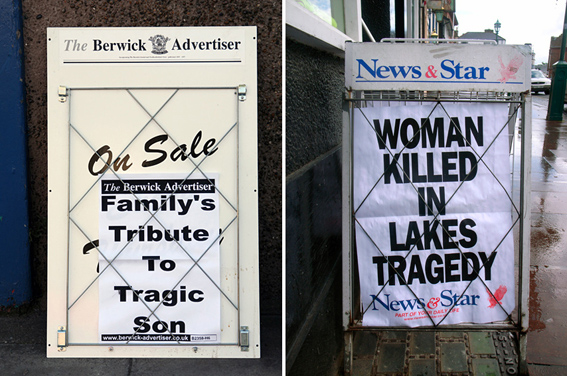September 22nd, 2008 admin
Wherever possible I bought a copy of the local newspaper in all the places we visited in order to explore the context within which my photographs were taken. More about this in a later post. For now, I want to talk about how visual media has become integral to our exposure to representation of death.Â
Over the course of a year I photographed newspaper billboards, mostly around London where I was living at the time, which dealt with the subject of death. With all these headlines the topic of death, often described in grizzly soundbites, was used to sell our daily news. Headlines such as: “Man’s Head Cut Off In DLR Train Horrorâ€, “Baby Savaged To Death By Dogâ€, “Victim of Black Magical Sex Killer†and “Shallow Grave Woman Battered To Death.†In some cases, we are also tempted by the fact that photographs are available: “McVeigh Ready to Die – Picturesâ€, “Child Victims Of Suicide Bomber – Picture†and “Hanratty Body Exhumed – Picture.â€
I collected forty-nine headlines and created a composite the shape and size of a newspaper billboard. My intention had been to the place them in Evening Standard billboards around London, however, I got cold feet, worried about being prosecuted!
Here is a small version of the composite-
Â
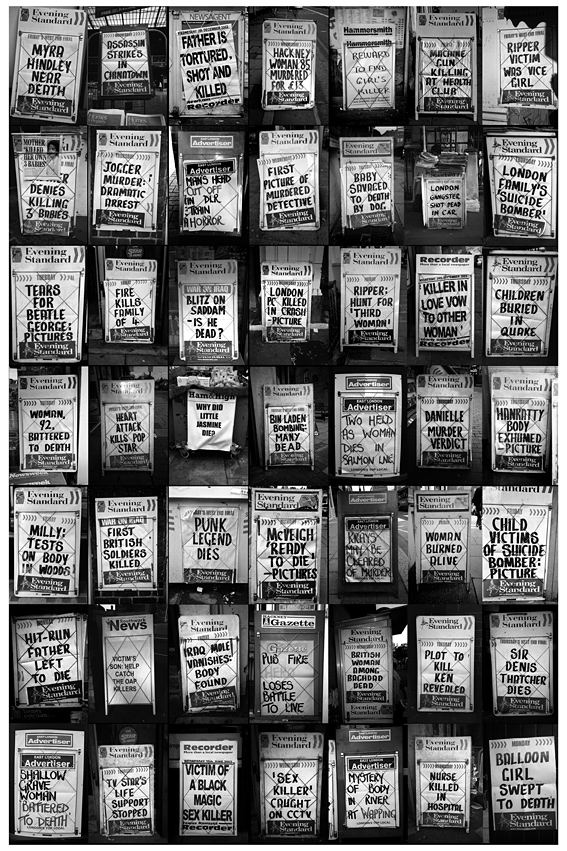
The aim was to explore how death is portrayed as entertainment, as sound bites and soap opera. This interplay between private and public experience often confers a false sense that we are sharing the drama of death in other people’s lives, while in reality we are completely insulated from it.Â
Posted in MISCELLANEOUS, RESEARCH | Comments Off on DEATH, READ ALL ABOUT IT
September 22nd, 2008 admin
Although a convert to life on the road, with another baby on the way, it’s time to sell our home of the last five months. If you want more details/photographs, give me a call.
TALBOT SWIFT CAPRI 520 GXL, 1993
£9750.00 ono
Â

49,000 miles, 5 Speed Manual, Diesel, 2+2 Berth, Overcab Bed, Side Kitchen with Oven, Grill, 4 Burner Hob, Sink, 3-way Fridge, Rear Washroom with Cassette Toilet, Shower, Hand Basin, Wardrobe, Leisure Battery, Mains Hook Up, Zig Unit, Hot Water, Heater, 3 x Lapbelts, Carpets/Upholstery Good Condition, Sunblind, Rear Ladder to Topbox, Bike Rack, Tow Bar, TV Aerial, 6 Month Warranty.
ps. I’ll supply some new hubcaps!
Posted in MISCELLANEOUS | Comments Off on ONE CAREFUL OWNER!
September 19th, 2008 admin
While I’m not generally a fan of photography compendium’s, I recently picked up Image Makers, Image Takers by Anne-Celine Jaeger and found some of the quotes to be quite revealing. The first section of the book is broken up into interviews with photographic artists, working within the disciplines of fine art, documentary, fashion, advertising and portraiture, where they are asked about what inspires them, the balance of technique and gift and the process of artistic creation. The second section has picture editors, curators, agency directors and art book publishers interviewed about what they look for in an image.
Â
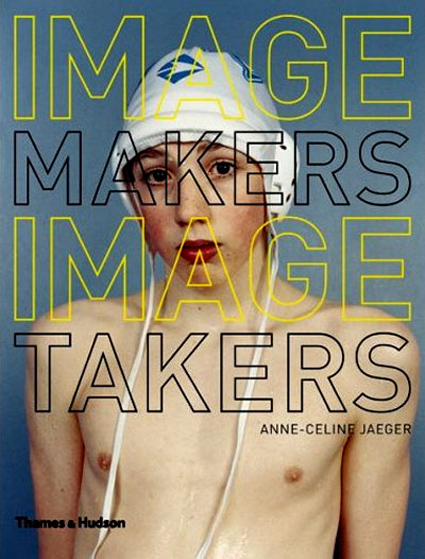
Here are some of the quotes-
William Eggleston is asked “How do you decide if something is worthy of being captured?”
“I never know beforehand. Until I see it. It just happens all at once. I take a picture very quickly and instantly forget about it. Not for good, but for the time being. Suddenly I just feel like I have to take a picture. Sometimes I’ll leave the house with a fully loaded camera and end up with nothing. It’s just about being there. Anywhere. Even the most uninteresting, ugly or boring places can for an instant become magical to me.”
William Eggleston quotes Garry Winogrand-
“When someone asked him why he took pictures, Garry said, ‘Because I want to see what something looks like when it’s photographed.'”
Stephen Shore is asked “Do you need a philosophy to do great work?”
“I would call it ‘intentionality’. Sometimes I meet young artists and it becomes clear that for some the main motivation is getting a show in Chelsea. It strikes me that this is very different to the way it was for me, which was that I wanted to understand photography and the world and myself. To do that, I produced work. The work that was shown was like a by-product, but never the purpose of my photography. The thought process doesn’t even have to be conceptual or intellectual. It can be visual, or a layer of thought that’s wordless. I’m always exploring some question or other, but it may not even be formulate as such. I believe the work produced by most established artists, was produced as a by-product of their personal explorations.”
Eugene Richards is asked “Do you see yourself more as a photographer or a journalist?”
“I go out into the world as a photographer, but I were to tell the truth, if I could become a very fine writer, I wouldn’t need to take photographs any more.”
David LaChapelle is asked “Do you think you can learn a way of seeing?”
“I think you either have it or you don’t. If you have it, you have to discipline yourself to prove it.”
Alec Soth is asked “Are you ever in the situation where you think I’m not sure that was in focus but you have to let it go?”
“All the time. It’s the bane of my existence. I miss pictures all the time. It kills me. But I’m technically better now and I also shoot more film, so I have better odds. I also have this problems that I try to get too much into a picture. I have to remind myself that photography is about limitation. It’s about not having everything there.”
William Eggleston is asked “What goes through your mind when you are framing a shot”?
“Nothing really. It happens so fast. I compose very quickly and without thinking, but conciously. I take a picture instantly and never more than one. Sometimes I worry about the picture being out of focus, but I take the chance. A long time ago, I would have taken several shots of the same thing, but I realised that I could never decide which one was the best shot. I thought I was wasting a lot of time looking at the damn near identical pictures. I wanted to discipline myself to take only one picture of something, and it didn’t work out, that’s just too bad. But it’s pretty much always worked.”
Martin Parr is asked “What are you thinking about, for example, when you are taking a picture in New Brighton of a young mother and kids eating chips opposite an over-flowing dustbin?”
“I’m thinking, ‘Here’s a family on their day out and the litter is spewing over because it’s a bank holiday weekend.'” (!?)
Posted in MISCELLANEOUS | 3 Comments »
September 17th, 2008 admin
Having pulled into Brighton on Monday morning my first stop was to Spectrum where I picked up all my film. As I mentioned in a previous post, I’d been sending back batches of film from the road each week for processing.Â
So it was a huge relief when Tim (pictured) presented me with a rather large pile of negatives, which I now have to pore over during the coming days. However, I’m reassured that after a quick scan through, they’re looking good. Now the hard work really starts – editing!
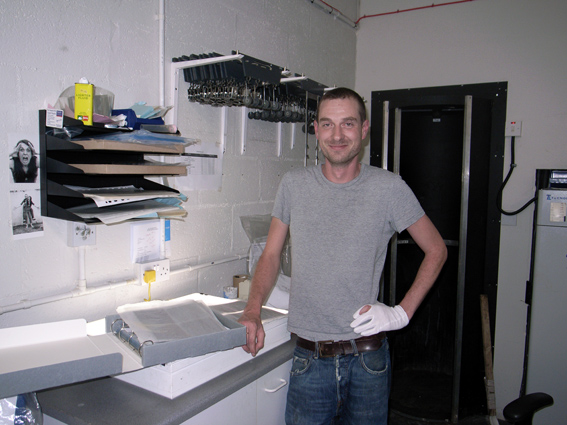
Posted in POST PRODUCTION | Comments Off on MEET TIM
September 17th, 2008 admin
I’ve just received details of an exhibition of photographs by Sir Benjamin Stone which are going on display in Centenary Square, Birmingham, from 20th September – 30 October 2008.
‘Knight of the Camera’ marks the first major display of images by the renowned Victorian amateur photographer, Sir Benjamin Stone, in his home town of Birmingham for almost a century. It follows on from the exhibition and publication project A Record of England: Sir Benjamin Stone and the National Photographic Record Association which was shown at the V&A in 2006 (more information below).
Â

The exhibition is being organised by Birmingham Library, where Stone’s archive is held, and will include over 100 of his most iconic images - from Parliament, customs and festivals and others such as his previously unseen photographs of the Franco-British Exhibition in London, 1908. Interestingly the exhibition will also include a ‘Legacy’ section revealing the influence of Stone’s work on subsequent generations of British photographers such as Homer Sykes, Daniel Meadows and Anna Fox. It’s being curated by Pete James who is head of Photographs at Birmingham Central Library and has undertaken extensive research on Stone’s collection for many years.
Â
A Record of England: Sir Benjamin Stone and the National Photographic Record Association, 1897 -1910Â
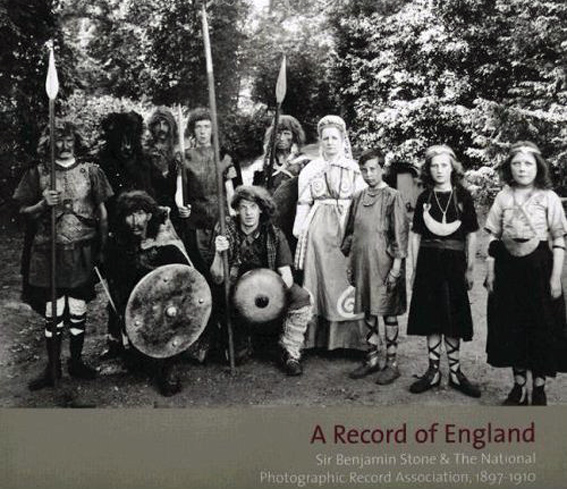
In July 1897, in a flourish of publicity, Sir Benjamin Stone – Birmingham industrialist, Member of Parliament and passionate, almost obsessive collector, announced the formation of the National Photographic Record Association. Its prime objective was to make a record of England for future generations, to foster “a national pride in the historical associations of the country, or neighbourhood, in family traditions, or in personal associations.” Over the next 13 years, Stone and his amateur supporters deposited their photographs at the British Museum. In 2000, these were moved to the V&A. This book examines Stone’s central role in the project and presents over 100 of his photographs, many of which have never been published before. It also charts the history of the NPRA and points to its legacies within photography.
Â
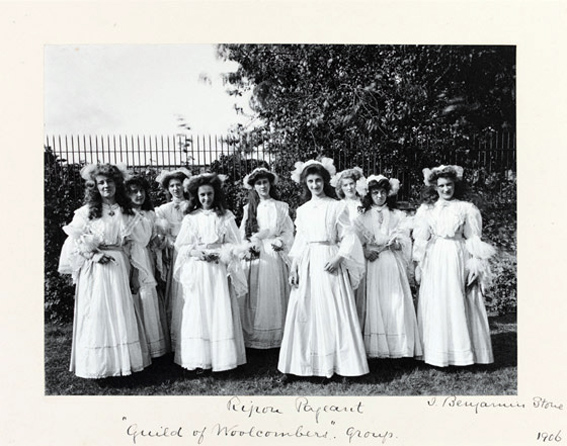
Ripon Pageant. Guild of Woolcombers Group. Ripon, Yorkshire, England 1906 © Sir Benjamin Stone, V&A
The NPRA was part of a much wider photographic survey movement at the end of the 19th century, covering British archaeology, geology and ethnography. The idea of photographic surveys survives to this day, operating at many levels, from local camera clubs and community projects to the National Monuments Record. While there are strong elements of nostalgia in the NPRA, it was also dynamic as our Victorian ancestors, like us, used photography to project what they valued about their past into the future.
You can see a selection of images from the V&A exhibition here.
You can read a biography of Stone here.
Posted in INSPIRATION, RESEARCH | Comments Off on KNIGHT OF THE CAMERA
September 14th, 2008 admin
After lunch yesterday, Mum pulled out some old photo albums from bygone holiday’s in the Lake District. Nothing like family nostalgia on a Sunday afternoon.
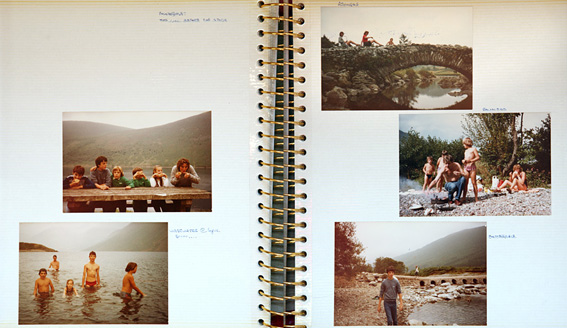
Â
On the subject of lunch, I was surprised by how many of our family photographs seemed to be centred around food. Such us eating ‘Roonies’ meat pies by Lake Ennerdale (the best pies in England reckons Mum) –
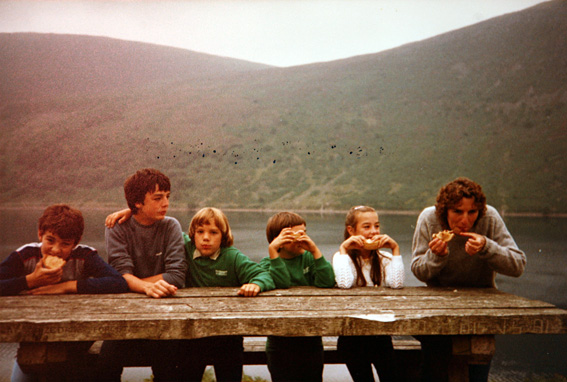
Â
Snacking on the summit of Anglers Crag-
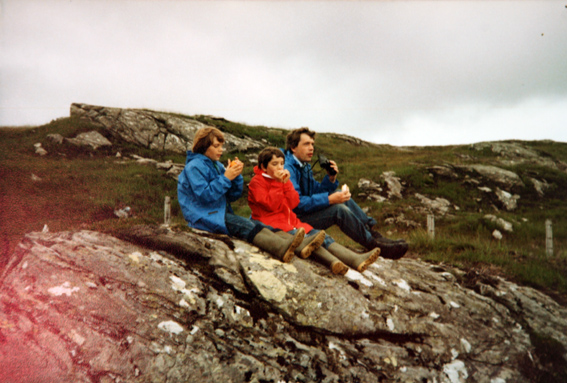
Â
Or barbequing on the shore of Crummock Water –
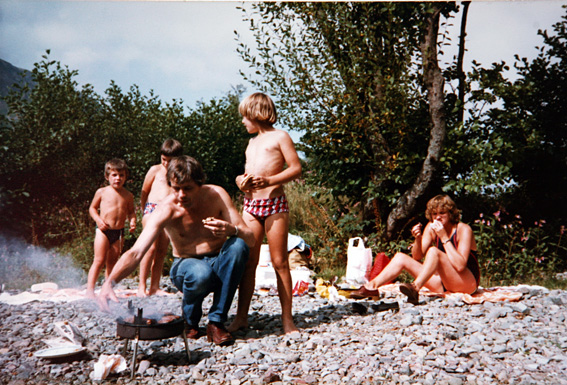
Â
My Dad was a keen amateur photographer and this is one of my favourite shots from the album, captioned:
“Wastwater at 6pm, Brrrrr”
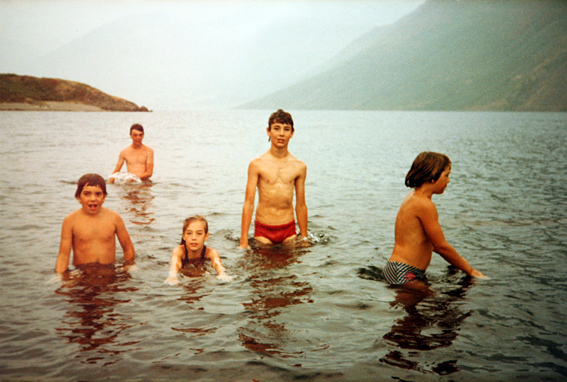
Posted in INSPIRATION | Comments Off on PICTURES FROM THE FAMILY ALBUM
September 14th, 2008 admin
We’ve made it! Well nearly. We’ve just pulled in to Oxted for Sunday lunch at my parents. This marks a psychological end to our journey. We’ll be back home to Brighton tomorrow. At this point, I want to pay a small tribute to Sarah and Jemima for enduring four months on the road, living in a confined space while putting up with an obsessive photographer. They coped admirably, especially Sarah who is now 34 weeks pregnant!
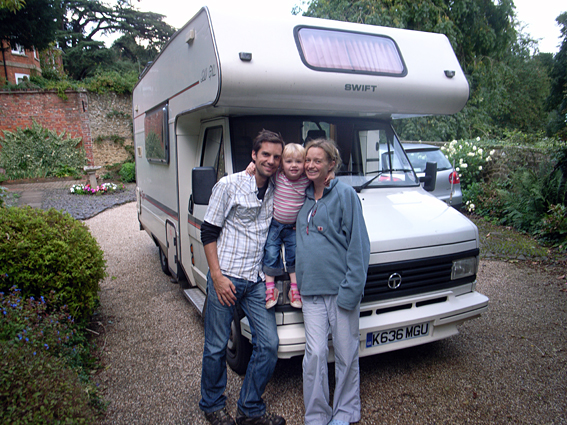
Â
Although it’s not particularly clear, you can get a sense of the ground that we covered in the map below -the ticks mark the places we stayed and/or where I photographed.Â
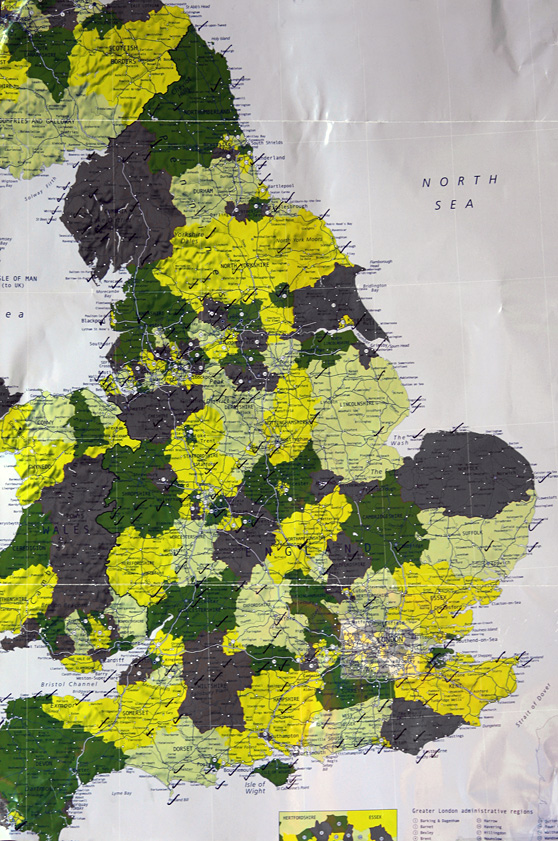
Â
Apologies to anyone from Cornwall, which has somehow managed to get chopped off the map! The only county that we didn’t visit is Buckinghamshire. Fear not, I will make a point of going there in the coming weeks. I’m actually going to continue shooting until the end of 2008, but this will be on a much more targeted basis once I’ve had a chance to edit the material I’ve already shot.
Posted in MISCELLANEOUS, TRIP LOGISTICS | Comments Off on HOME SWEET HOME
September 13th, 2008 admin
We visited Berwick-upon-Tweed last week, a town where L.S.Lowry spent a significant amount of time over the course of four decades. He visited the town many times from the mid-1930’s, often on holiday with his family, until the summer before he died. This gives me a good excuse to post up some of my favourite Lowry paintings, as part of my series on the Art of Leisure.
Laurence Stephen Lowry (born Stretford, 1887; died Glossop, 1976) was the only child of Robert and Elizabeth Lowry. He started drawing at the age of eight and in 1903, he began private painting classes which marked the start of a part-time education in art that was to continue for twenty years. In 1904, aged 16, Lowry left school and secured a job as a clerk in a chartered accountants firm, he remained in full time employment until his retirement at the age of 65. His desire to be considered a serious artist led Lowry to keep his professional and artistic life completely separate and it was not disclosed until after his death that he had worked for most of his life. He initially studied evening classes at The Manchester College of Art under Pierre Adolphe Valette a French impressionist painter one of whose specialities was urban scenes of Manchester. Later he learned the art of portraiture from the American painter William Fitz. It was from these artists that Lowry developed his trademark of stylised figures upon an industrial background.
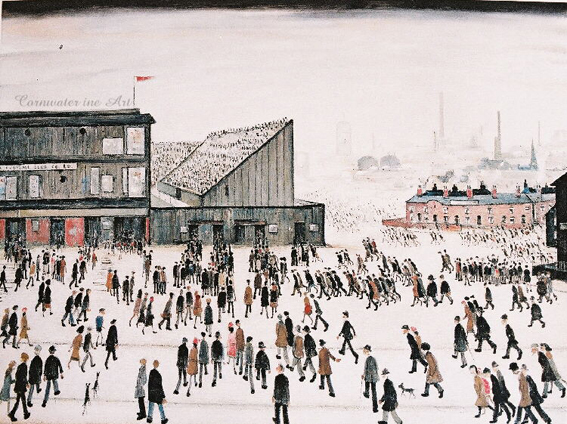
“Going to the Match” 1928, a painting which clearly depicts St. Michael’s Flags and Angel Meadow Park, Manchester.
In 1909, when in his twenties, Lowry moved to Pendlebury, where he spent much of rest of his life and drew inspiration from the mills and factories. In 1916, whilst waiting for a train, Lowry became fascinated by the workers leaving the Acme Spinning Company Mill; the combination of the people and the surroundings were a revelation to him and marked the turning point in his artistic career. Lowry now began to explore the industrial areas of South Lancashire and discovered a wealth of inspiration, remarking ‘My subjects were all around me … in those days there were mills and collieries all around Pendlebury. The people who work there were passing morning and night. All my material was on my doorstep.
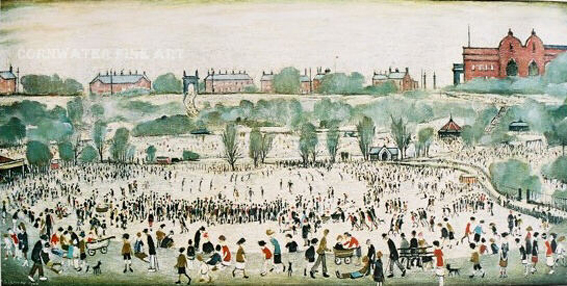
“Peel Park” 1927
Typical of Lowry’s urban landscapes, this is a vivid record of life in industrial northern England. His use of spindly figures, often termed ‘matchstick men’, have become the best-known feature of his work. In early paintings, each ‘matchstick’ figure was carefully and individually depicted. From about 1930, they became less distinctive – anonymous members of the crowd. Although he often depicted industrial cityscapes with some affection, Lowry also conveyed a sense of their bleakness. He invariably used drab colours to portray grimy urban buildings and overcast skies, dominated by ever present smoking factory chimneys.
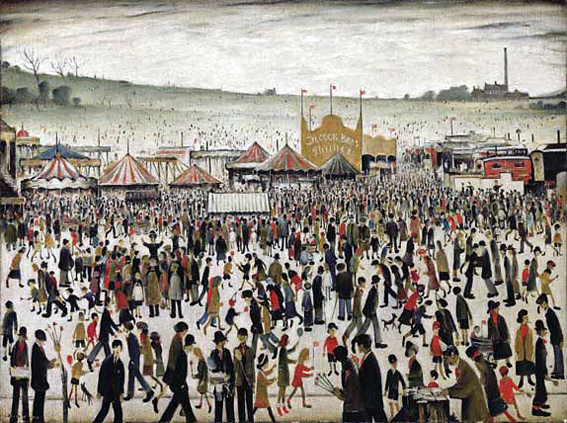
“Good Friday, Daisy Nook” 1946
This painting portrays the Lancashire town of Daisy Nook in festival mood. Traditionally, mill workers were confined to only two statutory days of holiday every year; Good Friday and Christmas Day. Every year on Good Friday, the town of Daisy Nook would stage a fair and provide entertainment to the local crowds. Managed by the Silcock family, whose name appears in the background of the painting, the fair regularly attracted huge numbers of people and still takes place to this day. The present painting depicts this annual fair in 1946, the year after the end of the hostilities of the Second World War. The Ashton Reporter stated at the time that there were ‘Record crowds at Daisy Nook’, as people celebrated a return to the fair and a return to normal life. The painting reflects post-war cheer and relief and depicts crowds of energetic, colourful characters, many holding whirligigs and flags.
On 8th June 2007 Daisy Nook was sold for £3,772,000, the highest price paid for one of his paintings at auction.
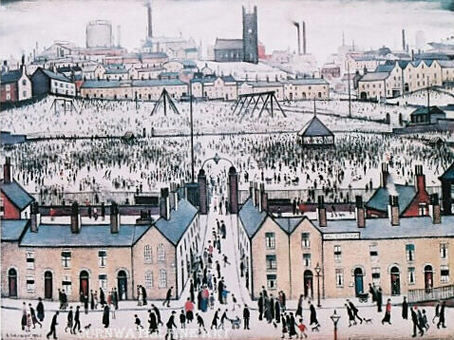
“Britain at Play” 1943
Lowry’s street scenes, peopled with workers, housewives and children set against a backdrop of industrial buildings and terraced houses had become central to his highly personal style. From now on he painted entirely from experience and believed that you should ‘paint the place you know’. Lowry’s leisure time was spent walking the streets of Manchester and Salford making pencil sketches on scraps of paper and the backs of used envelopes recording anything that could be used in his work.
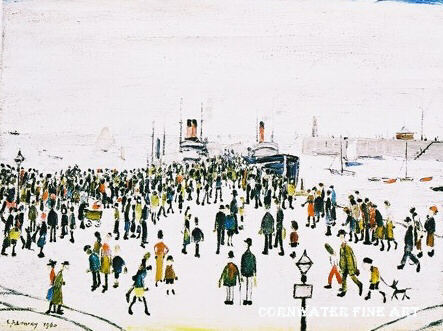
“Ferry Boats” 1960
From his first exhibitions in the 1920s, he built a reputation gradually, only achieving popular success when he was in his sixities, and continued to live a simple and private life. A humble man, Lowry holds the record for turning down the most honours including an OBE. In total he turned down five honour awards and declined the CH in 1972 and 1976.
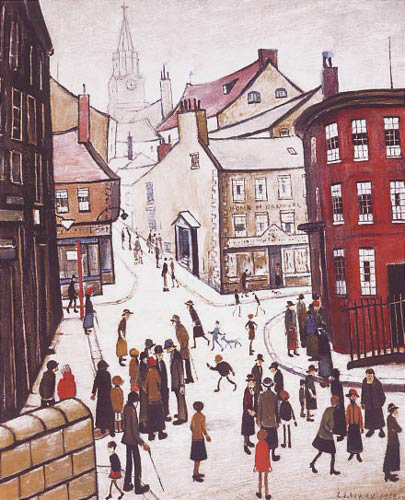
“Berwick Upon Tweed”
To read more about Lowry it’s worth looking at The Lowry Museum’s website here.
There’s an interesting article on the Guardian website by Jonathan Jones written in 2000 when the museum first opened. I’ve quoted a couple of paragraphs from the article here-
“The Lowry paintings worth looking at are the ones everyone knows. There’s no point trying to turn him into a well-rounded artist because he wasn’t one. He was a melancholy compulsive who painted the industrial north of England through deeply disturbed eyes, and caught aspects of it no one else was prepared to look at….Lowry painted the social world of Salford and Pendlebury systematically, illustrating how the factories produced people deprived of identity. His most disturbing images of the working-class crowd depict moments of supposed freedom and leisure: a drawing from 1925 of the bandstand in Peel Park shows people gathering like maggots around a piece of food, while above them the chimneys tower. Again and again he paints the crowd’s attempts at leisure as feeble reproductions of the discipline of the factory. Going to the Match (1953) makes supporting the local football team seem a desperate ritual. One of his scathing images of a crowd trying to forget the factory is called Britain at Play (1943).”
And here’s an article in The Observer by Vanessa Thorpe (March 2007) called ‘Lowry’s dark imagination comes to light’. It explores a much darker, sadder group of Lowry work rarely seen by the public, bleak sketches and paintings that include a series of disturbing and sexually deviant drawings. All had remained hidden until after the artist’s death in 1976. Lowry enthusiast Howard Jacobson argues that ignoring the bleak side of the artist’s imagination has led to him being under-rated and misunderstood by many art critics.
Posted in ART & LEISURE, INSPIRATION | Comments Off on L.S.LOWRY & LEISURE
September 13th, 2008 admin

Who on earth came up with the idea that we should spend thousands of pounds of tax payers money putting up signs with the letter Q above our motorways? I can see I’m in queue, I don’t need an illuminated letter telling me that.
Posted in MISCELLANEOUS | Comments Off on Q
September 12th, 2008 admin
We’ve made a slight diversion from the A1 and headed east to north Norfolk to visit Holkham, officially Sarah’s favourite spot in England!
While in the area I took the opportunity to call in on photographer Harry Cory Wright in his Saltwater Gallery. I was interested in meeting Harry as he recently undertook a similar endeavour. In March 2006, Harry took his large-format plate camera, and family, on a trip around the Britis Isles. Beginning in Unst in Shetland at the spring equinox, he travelled down through the Western Isles and mainland Scotland to Northumberland and further south through England and Wales. Merrel have just published the results in the book Journey Through the British Isles.
Â
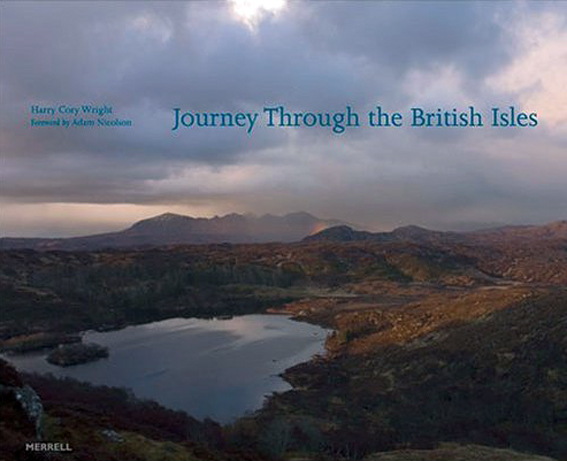
Â
You can read extracts from the blog Harry produced during his journey on The Times website here.
Â
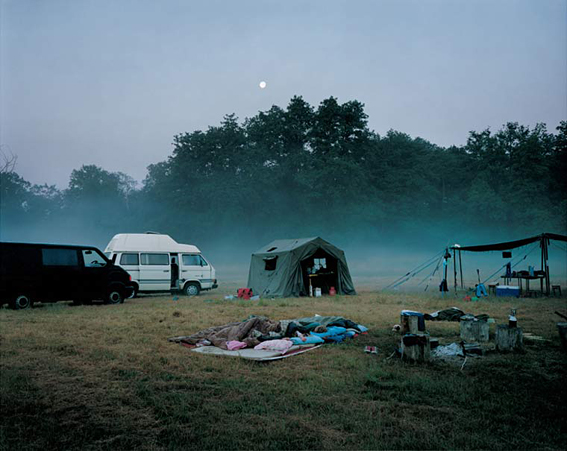
Camp at Tilhill © Harry Cory Wright
Posted in MISCELLANEOUS, RESEARCH | Comments Off on JOURNEY THROUGH THE BRITISH ISLES


